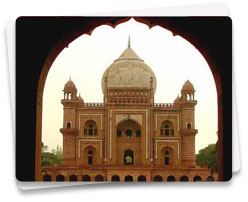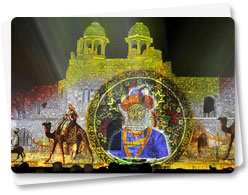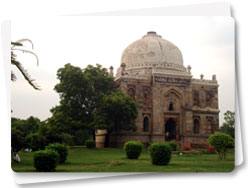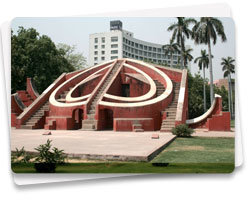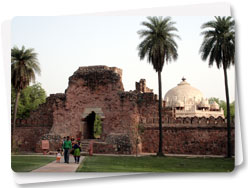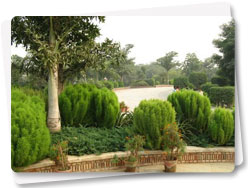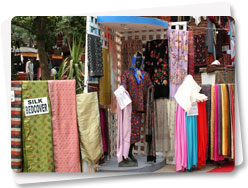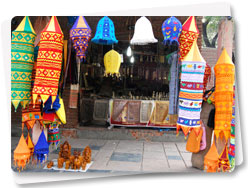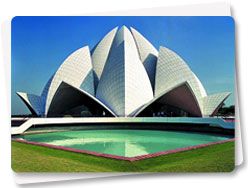The craftsmen who are registered with D.C.Handicrafts are the ones who are eligible to find a place here. The stalls selling handicrafts are allotted on a rotational basis to craftsmen who come from all corners of the vast & varied land of India at nominal payment for a period of 15 Days. This ensures that visitors get to buy authentic wares at prices that have not been inflated by high maintenance costs.
You can also savour the inimitable flavors of the delightful local foods from the various regions of India be it the
momos from Sikkim or the
Bamboos hot chicken from Nagaland,
Kahwa & Kebabs from Jammu,
Pooranpoli from Maharastra or the
Gujrati Dhokla. The food stalls offer you variety of foods served in an Eco friendly manner.
The
DILLI HAAT provides the ambience of a traditional Rural Haat or village market, but one suited for more contemporary needs. Here one sees a synthesis of crafts, food and cultural activity.
This Food and Craft Bazar is a treasure house of Indian culture, handicrafts and ethnic cuisine, A unique bazaar, in the heart of the city, it displays the richness of Indian culture on a permanent basis.
Step inside the complex for an altogether delightful experience by either buying inimitable ethnic wares, savouring the delicacies of different states or by simply relaxing in the evening with the entire family.
DILLI HAAT transports you to the magical world of Indian art and heritage presented through a fascinating panorama of craft, cuisine and cultural activities.
While the village haat is a mobile, flexible arrangement, here it is crafts persons who are mobile. The DILLI HAAT boasts of craft stalls selling native, utilitarian and ethnic products from all over the country.
An ambitious project, set up jointly by Delhi Tourism and NDMC, D.C. (Handicrafts) & D.C. (handlooms), Ministry of Textiles, Govt. of India & Ministry of Tourism, Govt. of India. It aims at providing encouragement to the needy artists from all over the country in order to sustain and preserve the rich heritage of India.
While allowing free interaction between buyers and sellers, the organizers favour a check on prices to keep them moderate.
Different and appealing,
DILLI HAAT is located in one of the most important commercial centers of South Delhi, opposite INA market. The 6 acres of land on which this sprawling complex is situated was salvaged as part of a reclamation project and transformed into a magnificent dream plaza. Extensive foundation work, small thatched roof cottages and kiosks with a village atmosphere have made the place into an attractive multiple center.
The word Haat refers to a weekly market in rural, semi-urban and sometimes even urban India.
DILLI HAAT is not just a market place; it has been visualized as a showpiece of traditional Indian culture- a forum where rural life and folk art are brought closer to an urban clientele.
It is here that the crafts persons find an opportunity to demonstrate their artistic skills to thousands of visitors everyday.
Since its inauguration in the month of March 1994, Dilli Haat has been home to thousands of handicraft and handloom artisans.
The complex is not only artistic, but also recreational in nature where the entire family can have a good time.
It is a place where one can unwind in the evening and relish a wide variety of cuisine without paying the exhorbitant rates.
There are stalls dishing out sumptuous delicacies from different States and Union Territories; an Exhibition Hall; a Souvenir shop selling an assortment of small gift items; an open stage for cultural programmes and a playing area exclusively earmarked for children.
Architecture
The architectural features of the complex have been especially designed in the traditional north Indian style, with brickwork jail (lattice) and stone roofs.
A hall in the complex specifically caters to exhibitions of the handlooms and handicrafts. A souvenir shop, also displays attractive ethnic products.
The small thatched roof cottages and kiosks, without any concrete structures provide a village atmosphere.
The shops are set up on platforms, which act as a link in the Bazar design. The courtyards between the shops are paved in stone and interspaced with grass to retain a visual softness.
The landscaping of the area incorporates colourful flowering shrubs and trees, thus the entire complex is in harmony with the environment.
Tickets
Cost of ticket is Rs.20/- for adult and Rs.10/- for child.
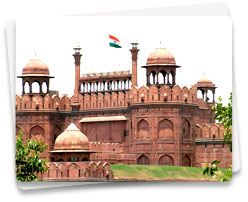 The vaulted arcade of Chatta Chowk, a bazaar selling tourist trinkets, leads into the huge fort compound. Inside is a veritable treasure trove of buildings, including the Drum House, the Hall of Public Audiences, the white marble Hall of Private Audiences, the Pearl Mosque, Royal Baths and Palace of Color.
The vaulted arcade of Chatta Chowk, a bazaar selling tourist trinkets, leads into the huge fort compound. Inside is a veritable treasure trove of buildings, including the Drum House, the Hall of Public Audiences, the white marble Hall of Private Audiences, the Pearl Mosque, Royal Baths and Palace of Color.
